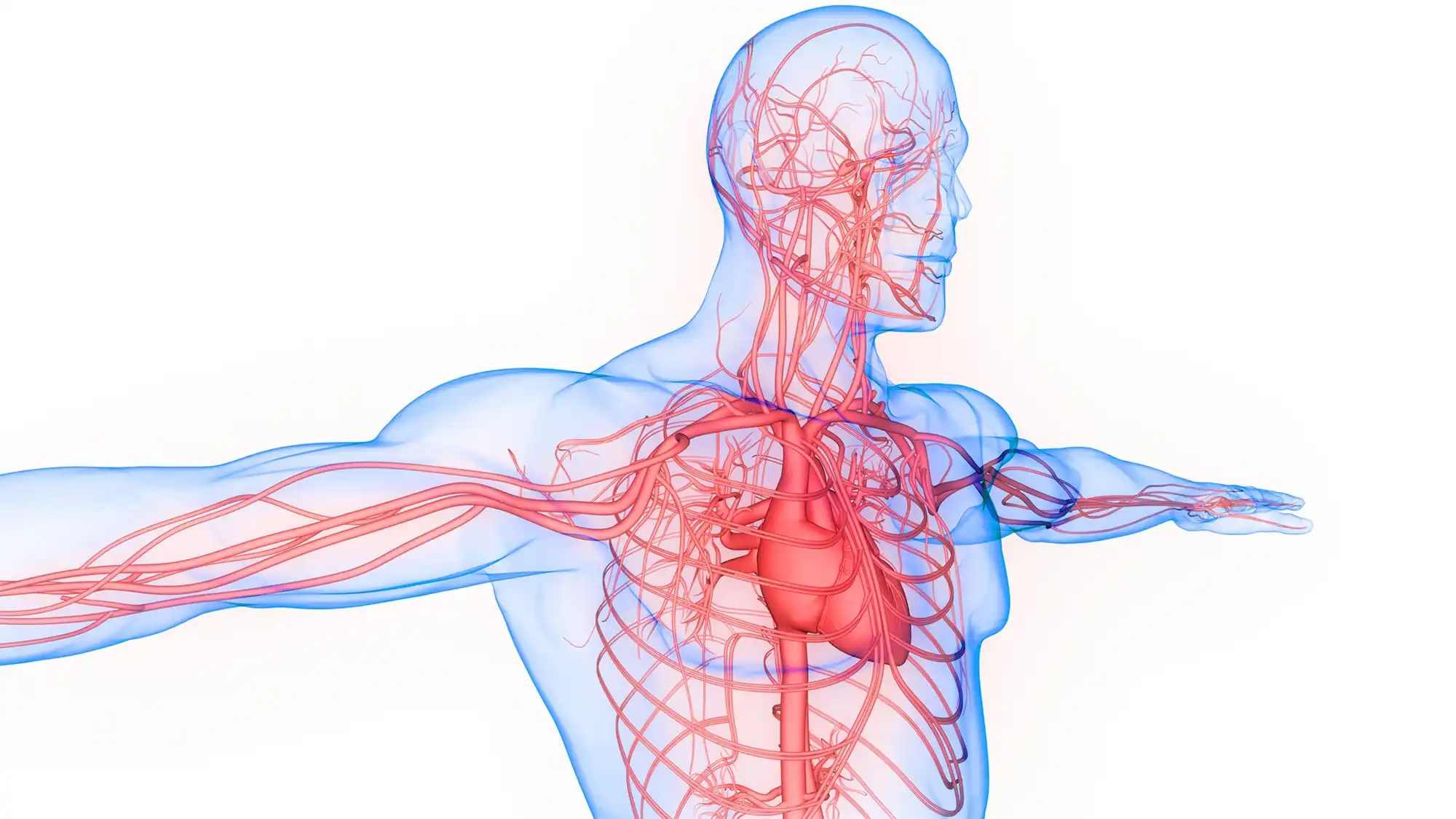At a glanceWhat's The Big Deal With Healthy Circulation? |
The cardiovascular system, sometimes called the blood vascular or circulatory system, is made up of your heart and a closed network of vessels such as your arteries, veins, and capillaries. This system is responsible for delivering nutrients and oxygen to all cells in your body. Together, your heart and blood circulatory system combine to deliver blood and oxygen around your body in a series of steps that include four chambers of your heart: the right atrium and right ventricle, and the left atrium and left ventricle. Your heart’s chambers may have different names, but all four are responsible for keeping your blood moving in the right direction.
On top of that, your heart contains four valves called the tricuspid, mitral, pulmonary, and aortic valves. They keep your blood moving in the correct direction by opening one specific way when necessary.
Your cardiovascular system is comprised of two connected circulatory paths: pulmonary circulation and systemic circulation.
The pulmonary pathway carries oxygen-depleted blood from your heart and to the lungs. It then returns oxygenated blood back to your heart.
The systemic pathway then provides oxygenated blood and nutrients to the rest of your body. From there, it returns de-oxygenated blood back to your heart.
Read on to discover how the circulatory system works, as well as steps you can take to support your circulation, nutrients to boost your blood flow, and more.
How Your Circulatory System Works
Circulation is defined as “the movement of blood through the vessels of the body induced by the pumping action of the heart.” In other words, it is a function responsible for moving blood throughout your body, as well as delivering oxygen and nutrients to cells, removing waste, and more.
The idea is simple: blood circulation is a key function in maintaining good health. But behind this basic principle is a series of complex functions that all play important roles in your circulatory system.
- Transportation: Blood carries nutrients to cells, transports hormones, and helps remove waste by delivering it to the liver and kidneys.
- Regulation: Blood helps regulate body temperature and retains a certain pH level to sustain bodily function.
- Protection: Blood clotting can prevent major blood loss from injuries. White blood cells are also an important part of the immune system.
The circulatory system, also called the vascular system, is made up of vessels that transport blood and lymph throughout your body. These vessels include arteries, veins, and capillaries. Each blood vessel plays a specific role in the circulation process.
- Arteries: Your arteries carry oxygenated blood away from your heart. Arteries feature a tough exterior but have a smooth interior that allows for blood flow, as well as a strong middle layer that helps blood pump through the body.
- Veins: Structured similarly to arteries but not quite as strong, your veins carry blood back to your heart. However, unlike arteries, your veins contain valves that make sure blood flows in only one direction.
- Capillaries: These tiny structures connect your arteries to your veins. Your arteries bring oxygen-rich blood to your capillaries, where the exchange of oxygen and carbon dioxide takes place. From here, they deliver the blood to your veins to bring back to your lungs and heart.
Simple Steps to Support a Complex System
We all know the importance of maintaining a healthy cardiovascular system. After all, a healthy heart is vital to overall good health — no matter what age you are. But when it comes to caring for our cardiovascular health, we may lose track of what functions we’re actually supporting.
You see, your cardiovascular system is a complex maze of over 60,000 miles of arteries and veins. That is enough to walk around the Earth more than twice! It is no wonder why this complex system plays a role in multiple vital functions throughout your body. But fear not: there are multiple daily activities that support this area of health — along with keeping your blood circulatory health in check — that are both easy and enjoyable to do.
Go For a Run
Sure, running helps increase stamina, build muscle, and may even put you in a good mood, but it has also been shown in studies to reverse age-related aortic stiffening.
A 2020 study published in the Journal of the American College of Cardiology set out to determine whether real-world exercise training for a first-time marathon can reverse age-related aortic stiffening. The study assessed a total of 138 first-time marathon completers aged 21 to 69 years. 51% of participants were women, while men made up the remaining 49%.
Multiple signs of encouragement — including decreased systolic and diastolic central (aortic) blood pressure and increased descending aortic distensibility — translated to a reduction of “aortic age” by 3.9 years and 4 years, respectively. Older, male participants with slower running time experienced greater benefits than the rest of the study’s demographics.
The study found that training for and completing a marathon, even at relatively low exercise intensity, reduced central blood pressure and aortic stiffness in participants the equivalent of 4 years of reduction in vascular age.
Channel Your Yoga-Heart Connection
Not all circulatory-boosting activity requires you to leave the house and revving up your heart rate. According to Johns Hopkins University, the calming exercise of yoga is good for the heart as well.
Hugh Calkins, M.d., Johns Hopkins’ director of Cardiac Arrythmia Service, stated, “A large number of studies show that yoga benefits many aspects of cardiovascular health.” Plus, Calkins recognized the growth in momentum of the connection between the heart and yoga: “There’s been a major shift in the last five years or so in the number of cardiologists and other professionals recognizing that these benefits are real.”
Furthermore, one of yoga’s top benefits to your heart lies within its ability to calm your body and mind. Stress narrows your arteries and increases blood pressure by releasing hormones such as cortisol and adrenaline. The deep breathing and mental focus exercises found in yoga appear to help mitigate this.

Nutrients To Boost Blood Flow
As stated, your cardiovascular system is a complex maze of over 60,000 miles of arteries and veins. And in order to support this vital system, we must nourish it with the right nutrients.
Vitamin K2
- An often-overlooked nutrient, Vitamin K2 has shown in clinical studies to support multiple key components of healthy circulation, including arterial flexibility and elasticity, as well as help keep blood pressure in the normal range. Vitamin K2 is also associated with the inhibition of arterial calcification and arterial hardening — two factors that could lower calcium-associated health risks.
- Sadly, the consumption of Vitamin K has decreased gradually since 1950 due to modern manufacturing processes that reduce the vitamin’s presence in food. And since a well-balanced diet may not yield enough of this particular vitamin, this opens the door for dietary supplements as a means of achieving adequate intake of Vitamin K.
Vitamin D
- The “sunshine vitamin” is linked to the health of your blood vessels. Research from the Emory/Georgia Tech Predictive Health Institute found that a lack of Vitamin D is associated with stiffer arteries and an ability of blood vessels to relax. Further, a dietary shortage of this vitamin may lead to impaired vascular health — a contributor of high blood pressure and risk factor of cardiovascular health.
- Ibhar Al Mheid, MD, a cardiovascular researcher at Emory University School of Medicine, stated, “We found that people with Vitamin D deficiency had vascular dysfunction comparable to those with diabetes or hypertension.”
- Al Mheid added, “Even after controlling for factors such as age, weight, and cholesterol, people with lower Vitamin D levels still had stiffer arteries and impaired vascular function.”
Polyphenols
- Food & Function, a scientific journal utilized by physicists, chemists, biochemists, and nutritionists to publish work related to the biology of food, stated there is clear evidence that suggests polyphenol-rich products and single polyphenols consistently increase cerebral blood flow. Polyphenols generate nitric oxide — a signaling molecule that helps to relax blood vessels and increase blood flow.
- A patented, French maritime pine bark extract called Pycnogenol® is one of the most studied ingredients in the world. Pycnogenol® is the subject of 40 years of research that has shown this unique pine bark extract helps support healthy circulation, blood flow, and healthy blood pressure.
- Nutritious sources of polyphenols include blueberries, grape seed extract, green tea, and bioflavonoids. Other sourceshttps://utswmed.org/medblog/polyphenols/ rich in heart-healthy polyphenols include apples, red wine, olive oil, and even chocolate.
Put These Tips into Circulation
We all know the importance of keeping our cardiovascular system healthy — from our heart to our arteries and veins to our blood flow. This complex system is in charge of distributing blood to all parts of your body, as well as delivering oxygen and nutrients while removing waste.
Your heart is the key organ in your circulatory system because it works as a muscular pump that disburses blood throughout your body. It “speaks” to the rest of your body when it needs to pump more or less blood depending on your current state. For example, when your body is at rest, your heart pumps just enough to give you the oxygen needed when you are asleep. When your body is moving, your heart works harder to meet your body’s oxygen requirements. This is just one important job of many vital tasks routinely carried out by your circulatory system.
With that in mind, we need to make the effort to support our circulatory system by participating in physical activity, supplementing with the right nutrients, and even practicing the mind and body boosting benefits of yoga!
References
https://www.fi.edu/heart/blood-vessels
https://www.hopkinsmedicine.org/health/wellness-and-prevention/the-yoga-heart-connection
https://www.jacc.org/doi/full/10.1016/j.jacc.2019.10.045
https://www.merriam-webster.com/dictionary/circulation
https://www.ncbi.nlm.nih.gov/books/NBK279392/
https://www.ncbi.nlm.nih.gov/pmc/articles/PMC4566462/
https://nineplanets.org/questions/how-many-miles-around-the-earth/
https://www.sciencedaily.com/releases/2011/04/110403205232.htm









